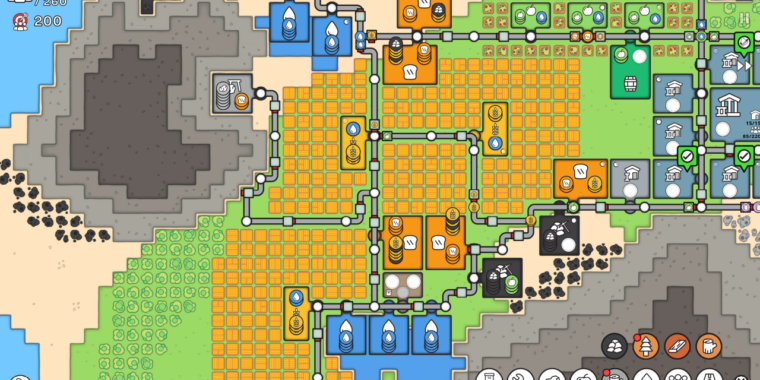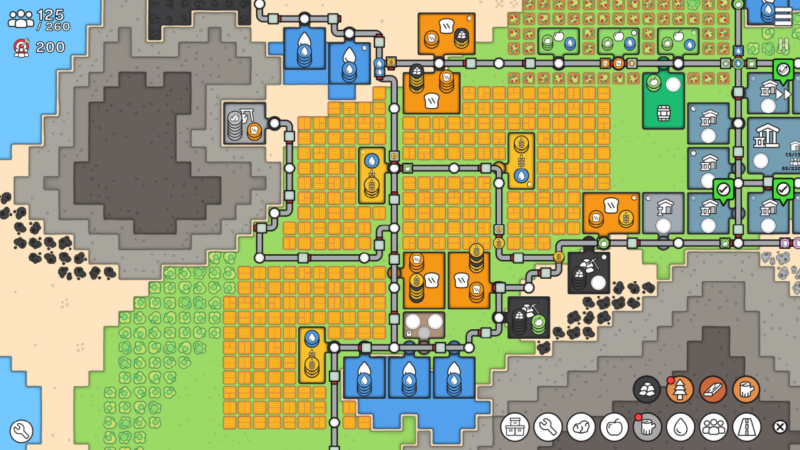

Goblinz Studio
You can’t buy Mini colonists right now, but I think you should play the free “Prologue” demo and add the full game to your wishlist if you like it. It’s not quite like any other city builder I’ve played.
Mini colonists is “mini” like minimalism. It’s in the same genre, but quite far removed from games like Cities: Skylines 2 (a choice with some proven merit). Your buildings are not displayed in 3D with real-time lighting. Your buildings are colored squares, sometimes with a few disc tokens stacked on top, table top style. Your roads have no traffic, but they have drivers (small squares) who transport resources between nodes. When something goes wrong, you don’t get depressing news about pollution and riots; some people just leave their house, but they come back if you solve the problem.
Mini colonists announcement video.
Mini Settlers is not the game you should play to satisfy your long-standing suspicion that urban planning was your missed calling. In the (non-progress saving) Prologue-free demo coming out this week, the mines and quarries have infinite resources. As far as I know there is no ‘money’ involved. Apple farms should be placed near apple orchards and water pumps, and the rest is up to you. The interface seems like a thought experiment on how far you can get from traditional city SIM HUDs, but someone implemented it.
-
A larger scale representation of a developed settlement, one with much better road planning than I achieved.
Goblinz Studio
-
The game combines information about resources and needs so it never feels overwhelming.
Goblinz Studio
-
Natural resources and land formations require you to use them in creative ways.
Goblinz Studio
-
Each circle is a node, and each square is a worker, transporting resources from node to node as best he can.
Goblinz Studio
The biggest challenge I faced during my few sessions was the logistics, at least from a suburban or small town perspective. Have developed SimCity Brain for the past few decades I’ve tried to keep my residential areas (the city center and the houses you build around it) away from anything that resembled manufacturing, like quarries and sawmills. Instead of boosting home values or improving aesthetics, which don’t exist, this gave me a huge set of supply bottlenecks to try to solve.
Houses wanted a regular supply of apples and water, but spreading everything out resulted in a lot of extra transport work. Each road consists of up to seven tiles, and each road is assigned a worker who moves back and forth between waypoints, delivering goods to buildings or leaving them for the next worker on the goods route. I wanted to create a simple town with people building wooden houses and eating apples, and instead I had a micro-scale Wayfair job application scenario, complete with small warehouses and delivery times.
But here again, Mini colonists is different even when you’re swinging. You simply remove the roads and buildings that don’t work and place them in better places. The buildings take a while to rebuild, but there’s no real game timer unless you want to turn one on for personal bests. You can even enable a background mode to keep the quiet simulation running while you do your absolute best work on Friday afternoons.
The “Prologue” has not been verified for Steam Deck, but the developers have an official layout for it. I think we’ll get it done in a pinch, but there’s still a lot of thumb-burdening trackpads left in a game that seems to be grid-based enough to work with more gamepad controls. As for performance, it drives great. At 30 frames per second, my Deck estimated it could take almost five more hours.
Mini colonists will be released in 2024, apparently only for PC on Steam for now. The minimum requirements are a Core i3, 4GB of memory and Intel HD Graphics 4000, but “integrated cards work too.” As the developers at Knight Owl Games note, wishlisting the game will keep it circulating within Steam’s recommendation algorithm, even if you don’t end up playing past the demo. I’m going to note here for the second time that the demo doesn’t save your game when you exit, which isn’t another design choice to keep you calm, just a demo thing.
Between this and Against the Storm, I enjoy the recent broadening of the ‘urban builder’ genre. It happens, strangely enough, by becoming much smaller.
Frame image from Goblinz Studio
Leave a Reply